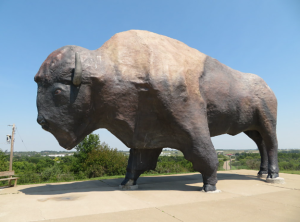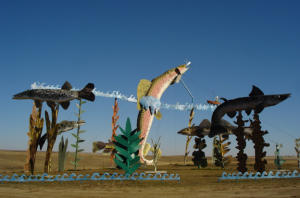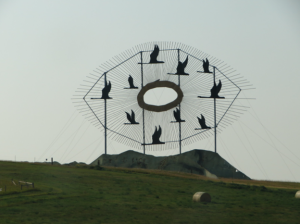Connor McKenney
Environmental Sculptures in North Dakota



Connor McKenney, Environmental Sculptures of North Dakota, planned license: CC BY-SA
This portfolio is about the importance of environmental sculptures to the state of North Dakota. The “World’s Largest Buffalo Monument” was designed by Elmer Petersen and is one of the first sculptures made in North Dakota. The “Fisherman’s Dream” and “Geese in Flight” sculptures are a part of the Enchanted Highway, a collection of the world’s largest scrap metal sculptures constructed by Gary Greff. The buffalo monument is present in this portfolio to show its importance in the culture of North Dakota. The pieces from the Enchanted Highway are present to show how junk can be used to show the beauty in the environment rather than be harmful to it.
The first theme that this portfolio is addressing is the ability for humans and nature to live in harmony. The second theme is the significance of nature in different cultures. The first theme is supported by the junk sculptures in the second and third images. These sculptures show that rather than throwing away junk that might cause harm to the environment, the artist was able to create art that showcases the beauty in nature. The second theme is supported by all these sculptures. These sculptures are all displaying animals that are significant to the culture of North Dakota. Not only are these animals significant, but through the creation of this art, these sculptures have become tourist attractions for the state and helped to tie the animals to the culture of North Dakota in people’s eyes.
The inspiration for all these sculptures came from the local wildlife experienced in North Dakota. The Enchanted Highway was created by Gary Greff to revive his hometown of Regent, which was experiencing economic and population decline. The buffalo sculpture, also known as “Dakota Thunder,” was one of the first sculptures made in North Dakota and helped start the trend in the state. “Dakota Thunder” was made to commemorate the history and significance of the buffalo in North Dakota. All these sculptures have become major tourist attractions for North Dakota.
The environmental sculptures of North Dakota are important for understanding the society within which they were created because they reflect the cultural, historical, and environmental values of the region. These sculptures serve as significant symbols and landmarks that contribute to the identity and sense of place for the people of North Dakota. The environmental sculptures represent the cultural heritage and traditions of North Dakota. They often depict elements that are closely tied to the local community’s identity. Many environmental sculptures in North Dakota celebrate the natural beauty and resources of the region. They emphasize the importance of environmental conservation, sustainable practices, and the relationship between humans and the natural world.
Media Attributions
- Picture1 is licensed under a CC BY-SA (Attribution ShareAlike) license
- Picture2 is licensed under a CC BY (Attribution) license
- Picture3 is licensed under a CC BY-SA (Attribution ShareAlike) license

